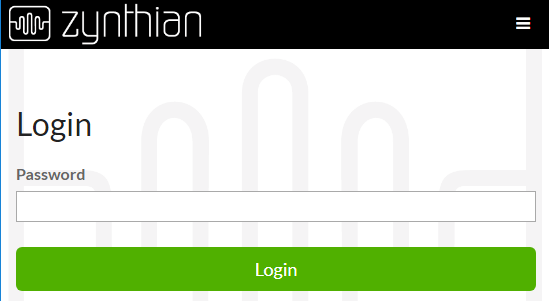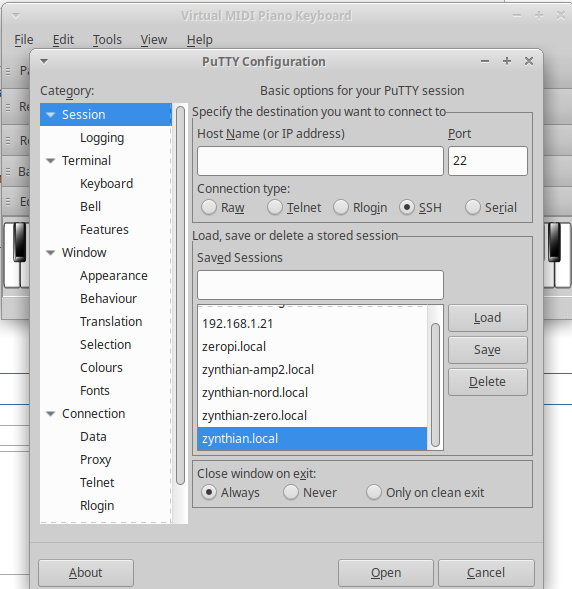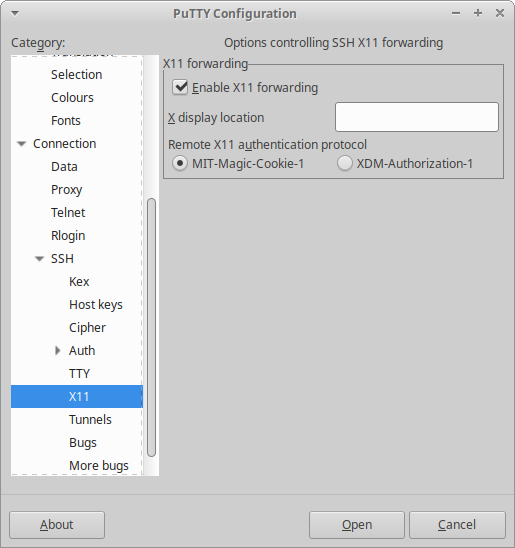Accessing Zynthian from your computer
1 Network Connection
The easier way of connecting your Zynthian is to use the Ethernet RJ45 connector with a CAT-5 cable to connect your unit to your local network or directly to your computer (Ethernet to Ethernet). Your Zynthian box uses the link-local name "zynthian.local" and its files can be accessed with sftp and scp (If you are using Windows, get Winscp - free software needed to communicate using this Internet protocol).
You can also login with ssh to access the Linux console. see Command_Line_User_Guide (use PuTTY software for Windows). The username and password are:
user=root password=raspberry
If the link-local address (zynthian.local) is not found, test that the link-local feature is enabled in your system. Sometimes is disabled and local names are not recognized (i.e. on Windows). Instead, you can use the Zynthian's IP address. Find out what that is using the "Network Info" utility in the Zynthian's Admin menu. or See: Finding your IP address
2 Accessing the Web Configuration Tool
You can access web configuration tool using the web browser from your computer:
- Connect your Zynthian to your local network using the ethernet connector (RJ45) or directly to your computer (Ethernet to Ethernet)
- Open the browser in your computer and type in the address bar:
zynthian.local (or the IP address of your Zynthian)
(If zynthian.local does not work, see Finding your IP address )
The web config tool will load and prompt for the admin password. It is "raspberry".
Here's details on using the Web configuration tool: Configuration_Users_Guide
3 Wifi Configuration
Wifi credentials can be set via the web config tool: System - Wifi - Add Network. Wifi must be enabled in the Zynthian Gui: press the Back button until you are in the Admin menu. Then select 'Start WIFI'.
4 Audio Configuration
5 Accessing the MOD-UI web interface
If you have a recent zynthian image with MOD integration (Gorgona or later), you can access the MOD-UI web interface using the web browser from your computer:
- Connect your Zynthian to your local network using the ethernet connector (RJ45) or directly to your computer (ethernet to ethernet)
- Open the browser in your camputer and type in the address bar:
zynthian.local:8888
The MOD-UI webpage should appear. Enjoy! ;-)
If the link-local address (zynthian.local) is not found, test that the link-local feature is enabled in your system. Sometimes is disabled and local names are not recognized. Instead, you can use the zynthian's IPaddress. Find out what that is using the "Network Info" utility in the Zynthian's Admin menu.
6 Opening Synth Engine Native GUIs in your Computer
You can attach an HDMI monitor, mouse and keyboard to your Zynthian, run startx to display the LINUX desktop and access the various synth engines,
or
You can remote login from another computer/laptop. To do this, you need an XServer running on your computer. Linux is best, but i've tested with Mac and Windows too. The only thing you have to do is login into your Zynthian Box with ssh using the "-Y" option to tunnel the X connection (or the equivalent option if you are not using a standard ssh client):
$ ssh -Y root@zynthian.local
or use vnc:
SSH into the zynthian box and enter:
# apt-get install vnc4server blackbox # pico ~/.vncrc
and enter this line to set the desktop size:
$geometry = “2048x1600”;
start the vnc server:
# vnc4server
Connect to the vnc server using (e.g.) windows TightVNC viewer.
or use Putty:
works on Windows and also is available in Linux and makes a handy alternative to command line ssh.
You should set the X11 Windows options:
Currently only ZynAddSubFX has a supported native GUI. The ZynAddSubFX will be launched automatically when a ZynAddSubFX patch is selected. Other GUI software can be installed to control other synths, also virtual MIDI keyboard software can be used - for testing.
IMPORTANT: Try to use an ethernet-to-ethernet connection as it will reduce latency and improve usability.
7 Copying your presets/soundfonts to Zynthian
You can copy your presets/soundfonts/pedalboards in the next forlder:
/zynthian/zynthian-my-data
There are different subfolders:
+ mod-pedalboards + soundfonts + gig + sfz + sf2 + snapshots + zynbanks
In 'mod-pedalboards' you will find your stored MOD-UI pedalboards. Use SFZ and GIG soundfonts with LinuxSampler. SF2 soundfonts must be used with FluidSynth. SFZ and GIG fonts must be stored in 'category' subfolders. User's ZynAddSubFX presets/banks must be stored in the "zynbanks" directory.
If you have doubts of how to store your data, take a look in this directory:
/zynthian/zynthian-data
Here you will find the same folder structure, with some additions.
If you are really interested, you could, for instance, edit the setBfree configuration, and change the CC assignments, etc.
IMPORTANT: after adding or changing something in 'zynthian-data', you can’t update the zynthian-library from the Admin menu. (The "git-based" updating system should be improved...)
If you are using an old SD image (prior to Gorgona), the username and password are the default for Raspbian:
user=pi password=raspberry


